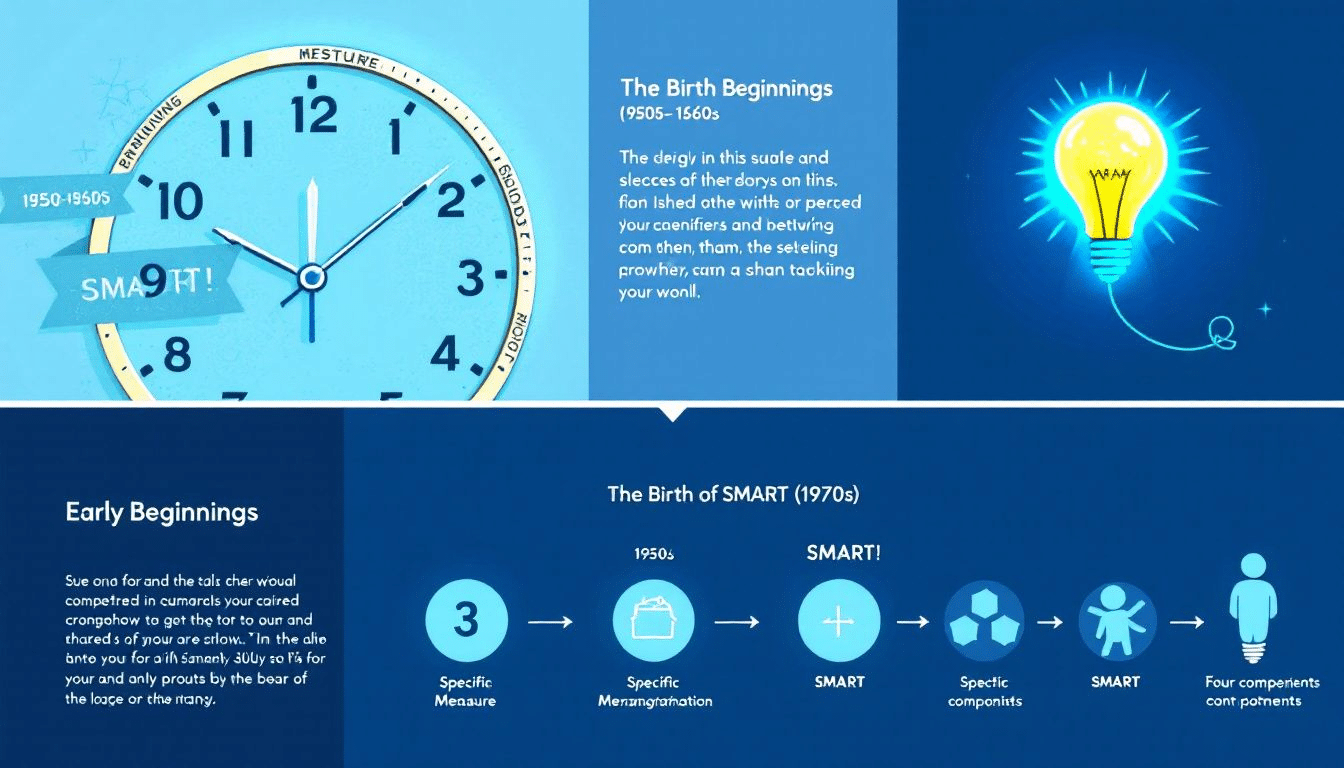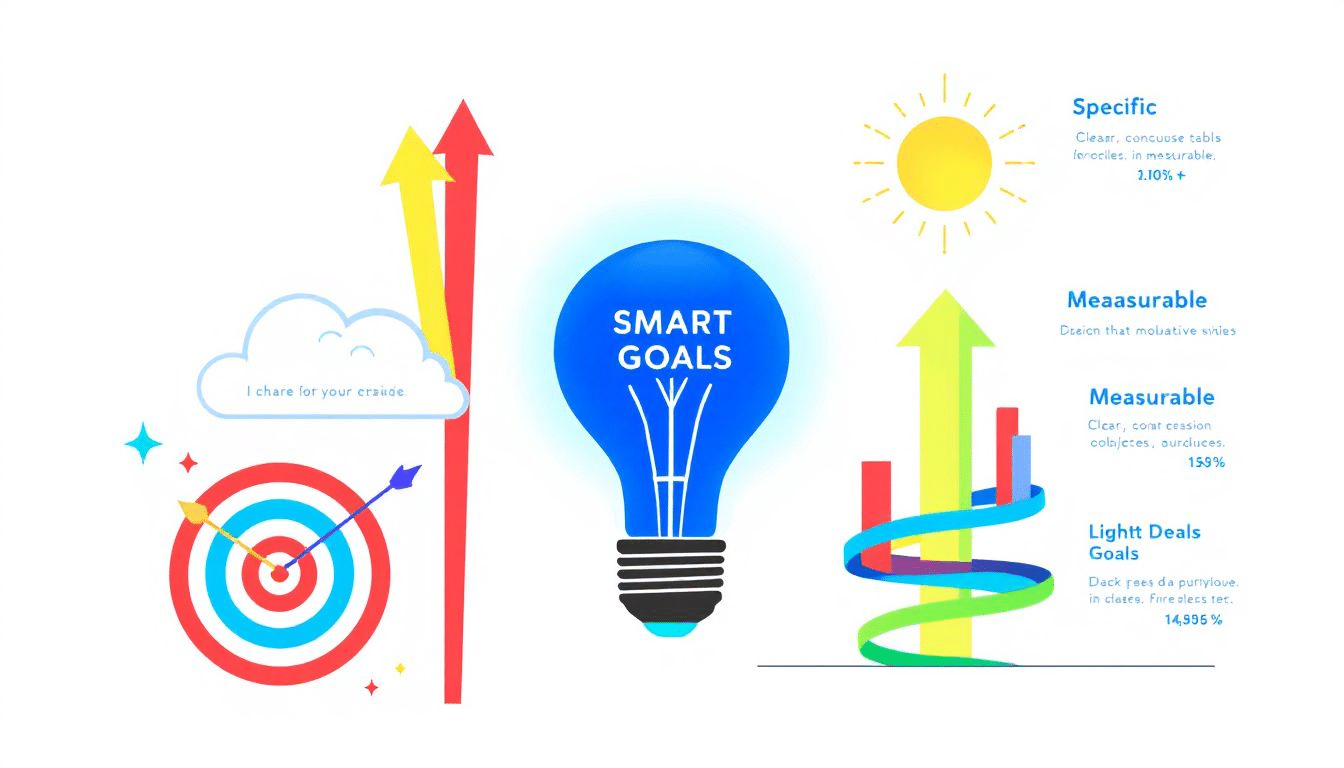In 1981, George T. Doran introduced the SMART goals framework to help individuals and organizations set clear, achievable objectives. This article dives into the origin of SMART goals, including the question of who came up with smart goals, its key contributors like Peter Drucker, and how to effectively implement and benefit from this widely-used methodology.
Key Takeaways
-
SMART goals, introduced by George T. Doran in 1981, provide a structured and clear approach to setting objectives, enhancing effectiveness and accountability in both personal and professional contexts.
-
Key components of SMART goals – specificity, measurability, achievability, relevance, and time-bound criteria – ensure clarity, motivation, and focus, helping individuals and organizations track their progress effectively.
-
The SMART framework has evolved over time, allowing for adaptability in different fields and ensuring that goal-setting remains relevant and effective in achieving desired outcomes.
The Origin of SMART Goals

The concept of SMART goals was introduced by George T. Doran in 1981. Faced with the prevalent issue of vague and undefined objectives in the business world, Doran sought to provide a solution that would bring more clarity and precision to goal setting. His innovative framework aimed to make management’s goals and objectives specific, measurable, achievable, relevant, and time-bound, thereby addressing the lack of clarity that often plagued organizational strategies.
Doran aimed to enhance goal-setting effectiveness within organizations. He believed clear, measurable objectives could significantly improve business strategic planning and execution. His framework fostered a disciplined approach to achieving long-term goals and set the stage for writing effective objectives.
Key Contributors to the Development of SMART Goals
George T. Doran’s 1981 article laid the foundation for what we now know as SMART goals. His criteria included specificity, measurability, assignability, realism, and being time-related. These elements aligned with effective management practices, offering a structured approach to goal setting. Doran’s work emphasized the importance of having clear, well-defined objectives, which has since become a cornerstone of modern management.
Another key contributor to the development of SMART goals was Peter Drucker, whose concept of Management by Objectives (MBO) significantly influenced Doran’s framework. Drucker’s MBO emphasized the necessity of setting clear, measurable goals that aligned with broader organizational objectives.
This approach required employee involvement in the goal-setting process, fostering a sense of accountability and clarity regarding individual roles. Drucker’s principles were instrumental in shaping the SMART criteria, ensuring that goals were not only clear and measurable but also aligned with the organization’s strategic vision.
Doran and Drucker significantly influenced organizational goal formulation and pursuit. Their contributions made goal-setting more systematic and effective, aiding businesses in achieving objectives with greater precision and accountability.
The Evolution of the SMART Acronym
Since its inception, the SMART acronym has evolved to include various extensions, such as smarter goals, which introduces additional criteria for goal-setting. This enhanced version of the framework provides a more comprehensive approach to writing effective objectives, ensuring that goals are not only specific, measurable, achievable, relevant, and time-bound but also evaluated and reviewed regularly.
The SMART acronym’s evolution reflects its adaptability and influence across different fields. Over time, each component’s definition has diversified, allowing personalized adaptations for individual and team needs. This flexibility has made project smart goals a versatile tool in various contexts, from corporate settings to personal development, including the use of a smart stand.
Why SMART Goals Are Important

SMART goals provide clarity, motivation, and focus, crucial for success. Clearly defined goals help individuals and organizations set clear targets, enhancing strategic planning and preventing confusion.
A significant benefit of SMART goals is their emphasis on realism. Setting realistic goals fosters belief in their achievability, essential for maintaining motivation and commitment. Goals that are too ambitious or too vague often lead to frustration and failure. Specific and realistic goals help individuals and teams stay on track and make meaningful progress.
Deadlines and time-bound criteria are also integral to the SMART framework. Having a clear timeline creates a sense of urgency and accountability, helping to maintain momentum and focus. Balancing work-related goals with personal aspirations ensures overall well-being and happiness. This holistic approach makes SMART goals invaluable for both personal and professional development.
How to Implement SMART Criteria
Implementing SMART criteria means setting goals that are specific, measurable, achievable, relevant, and time-bound. George T. Doran introduced this structured approach to help individuals and organizations set clear and effective objectives.
Tracking progress, regularly reviewing goals, and making necessary adjustments are key to maintaining motivation and achieving success through management review.
Specific
Specificity in goal setting prevents confusion and ensures everyone understands the target. A specific goal should outline responsibilities and steps for achievement. For instance, a sales manager might set a goal to sell at least 100 products in the next quarter, providing a clear and focused objective for the team.
Without specificity, teams may struggle to stay on track and achieve their goals, leading to miscommunication and a lack of direction. Creating specific goals defines what needs to be done, who is responsible, and the expected outcomes in project management.
This clarity helps keep everyone aligned and focused on the end goal.
Measurable
Measurable goals use quantifiable measurements, essential for tracking progress and assessing success. A measurable goal includes clear metrics indicating whether the goal is achieved. For example, a goal to increase channel partner sales by 20% provides a specific benchmark to measure performance against.
Incorporating quantifiable benchmarks helps in tracking progress and making necessary adjustments. Terms like ‘increase,’ ‘decrease,’ and ‘maintain’ set clear expectations and provide a basis for evaluating success through key performance indicators.
Establishing measurable goals ensures that progress can be monitored and celebrated, keeping motivation high.
Achievable
An achievable goal must be a realistic goal within the time frame and consider individual capabilities. It requires significant effort but remains within reach, ensuring the goal is neither too hard nor too easy. For instance, setting a goal to increase sales by 50% when the average increase is only 10% would be unrealistic and likely lead to disappointment.
Assessing a goal’s achievability involves considering historical data and the success of similar positions, ensuring the goal is reasonable and within the individual’s or team’s capabilities. Achievable goals keep motivation high and encourage steady progress, making them a critical component of effective goal setting and helping to achieve goals.
Relevant
For goals to be effective, they must be a relevant goal and align with individual roles, responsibilities, and broader organizational objectives. Relevance ensures that the goals are worthwhile and appropriate for the individual’s capabilities and focus.
Connecting goals to the bigger picture helps individuals and teams see the value in their efforts and stay motivated.
Time-bound
Deadlines provide motivation and help establish a sense of urgency, which is crucial for maintaining focus and momentum. A time-bound goal includes a clear timeline that indicates when the goal should be achieved. For example, setting a quarterly goal helps balance the need for planning with maintaining a sense of urgency.
Effective time-bound goals include milestones throughout the year for longer-term objectives, ensuring consistent progress and allowing for adjustments as needed. By setting time-bound goals, individuals and teams can prioritize their efforts and stay on track to achieve their targets.
Examples of SMART Goals in Practice

SMART goals can improve performance and achieve desired outcomes in various fields. For instance, a customer service department might set a smart goal to expand staff from 3 to 8 within a year to improve response times. This specific, measurable, achievable, relevant, and time-bound goal provides a clear roadmap for enhancing customer service.
In the realm of employee retention, a company might aim to reduce turnover by 15% in 90 days through targeted training and one-on-one meetings. This goal is specific, measurable, and time-bound, making it an effective strategy for improving employee satisfaction and retention.
Personal development goals also benefit from the SMART framework. For example, increasing social media leads by 15% by the end of Q3 is specific, measurable, achievable, relevant, and time-bound, providing a clear path to personal growth and success.
Common Pitfalls and How to Avoid Them
A common pitfall in goal setting is creating unrealistic goals, leading to discouragement when they are not achieved. Ensuring goals are realistic and within reach maintains motivation and commitment. Additionally, underestimating the time required to complete tasks can result in frustration and increased pressure.
Setting too many goals simultaneously can dilute focus and energy. Prioritizing goals and concentrating on a few key objectives at a time avoids this issue. Learning from failures is also crucial, as they provide valuable insights for future goal-setting efforts.
Understanding and avoiding these pitfalls helps individuals and teams set more effective and achievable goals.
Summary
In summary, SMART goals are a powerful tool for achieving clarity, focus, and success in both personal and professional contexts. By ensuring that goals are specific, measurable, achievable, relevant, and time-bound, individuals and organizations can set clear targets and make meaningful progress. The contributions of pioneers like George T. Doran and Peter Drucker have significantly shaped the way we approach goal setting today.
As you embark on your goal-setting journey, remember the importance of realistic and well-defined objectives. By implementing the SMART criteria, you can turn your aspirations into actionable plans and achieve the success you desire. Stay focused, stay motivated, and let SMART goals guide you to your ultimate achievements.
FAQ
Who introduced the concept of SMART goals?
SMART goals were introduced by George T. Doran in 1981 to create clear and actionable objectives. Embrace this framework to achieve your dreams effectively!
How did Peter Drucker contribute to the development of SMART goals?
Peter Drucker significantly shaped SMART goals through his Management by Objectives (MBO) approach, which highlighted the necessity of establishing clear and measurable goals that resonate with overarching organizational aims. Embrace this clarity and watch how it propels your progress!
What does the SMART acronym stand for?
The SMART acronym stands for Specific, Measurable, Achievable, Relevant, and Time-bound, offering a powerful framework to effectively set and achieve your goals! Embrace this method to turn your aspirations into reality!
Why are SMART goals important for organizations?
SMART goals are crucial for organizations as they foster clarity, focus, and motivation, significantly boosting the chances of success. By setting clear targets, they enhance strategic planning and drive effective outcomes.
Can you give an example of a SMART goal in practice?
A great example of a SMART goal is to reduce employee turnover by 15% in 90 days using targeted training and one-on-one meetings. This clear strategy not only motivates your team but also sets a tangible path for success!
